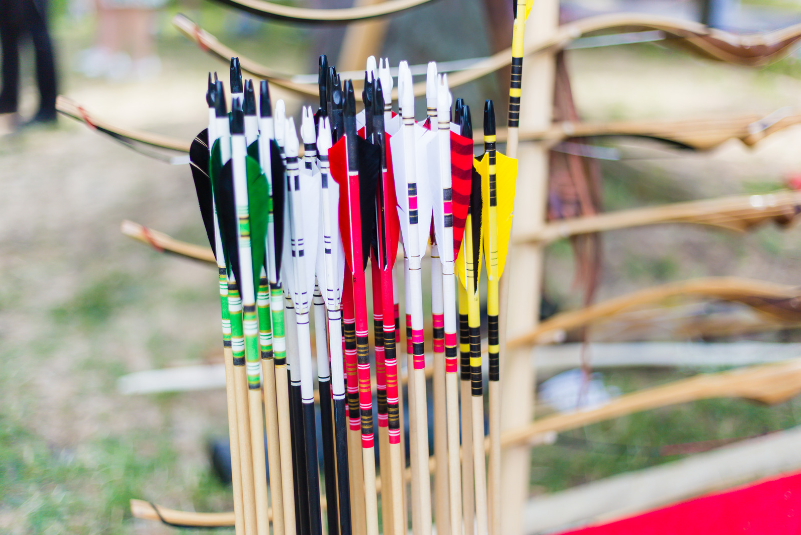
Choosing the Right Arrows: Key Factors for Improving Archery Performance
Even today, seasoned archers know that the main consumable every year is arrows. In fact, arrows are more important than the bow itself. A good bow with poor arrows will not produce good results, even in the hands of a skilled archer. Conversely, a mediocre bow with high-quality, well-matched arrows can still yield good outcomes.
Many new archery enthusiasts overlook the importance of arrows and use any type they can find. This can lead to poor performance at best, and at worst, can damage bows or even cause personal injury.
Now, let's discuss arrows and arrow shafts.
What Makes a Good Arrow?
A good arrow should possess the following general attributes: straightness, durability, longevity, proper balance, high consistency, and minimal impact from environmental conditions like temperature and humidity. Personalized attributes include compatibility with your bow, such as length, spine, weight, and the configuration of the arrowhead and fletching.
What Are the Materials Used for Arrow Shafts?
A. Wooden and Bamboo Arrows: Primarily used for traditional bows in performance contexts, these arrows are rarely used in competitions or hunting due to their tendency to deform, poor straightness, low consistency, lack of durability, and difficulty in controlling weight and spine. I have used wooden arrows and witnessed one disintegrate in flight.
B. Fiberglass Arrows: These are low-end arrows, often considered more for display. They are heavy but not durable and are unsuitable for high-poundage bows.
C. Carbon Arrows: Many archers use carbon arrows, which are generally a good choice due to their excellent straightness and resistance to bending and deformation. However, they can shatter, are lightweight, and are not suitable for high-poundage bows. I used to use them but have since stopped.
D. Aluminum Arrows: I have always found aluminum arrows to be a solid choice due to their high safety, consistency, and ease of matching with bows. However, they do have drawbacks: they bend easily, are relatively expensive, and are not suitable for low-poundage bows.
E. Carbon-Aluminum Arrows: These combine the advantages of both carbon and aluminum arrows but come with a high price tag. A dozen carbon-aluminum arrows can cost over 2000 yuan. They are suitable for competitions, but losing one in the wild can be quite distressing.
What Are the Key Considerations for Arrow Shafts?
A. Length: The length should match your draw length. For example, if your draw length is 28 inches, your arrows should be around 29 inches long, measured from the arrowhead seat to the nock. If you see someone with arrows sticking out far beyond the bow in a movie or photo, they probably don’t know archery or are using found arrows. To measure your appropriate draw length, stand straight with arms extended and palms facing forward. Have someone measure from the tip of one middle finger to the other. Divide this measurement by 2.5 to get your draw length in inches. The standard bow draw length is 28 inches, but most Chinese people have shorter arms, typically around 27 inches. For Mongolian archery, the draw length can be 3-4 inches longer as they draw to the ear.
B. Straightness: This refers to how straight the arrow is. Nowadays, standard arrows have a straightness of 6/1000, meaning no more than a 1-millimeter deviation in the middle of a 1-meter arrow. Higher-quality arrows have better straightness.
C. Spine: This refers to the stiffness of the arrow, which correlates with the bow's poundage and the arrow's length. Generally, the lower the poundage, the softer the arrow; the higher the poundage, the stiffer the arrow. Arrows bend during flight, and only proper bending ensures accuracy. Both overly stiff and overly soft arrows will affect accuracy. The standard measurement involves placing a 29-inch arrow shaft on two supports 28 inches apart and applying a 0.88 kg (1.94 lbs) weight in the middle, measuring the deflection in thousandths of an inch. EASTON has software to help select arrows; you can input your personal metrics, and the software's recommendation is usually reliable.
D. Weight: The arrow's weight should match the bow's poundage. Typically, the arrow weight in grains per pound of draw weight ranges from 5-12 grains/pound. One grain equals approximately 0.0648 grams. If your bow is 50 pounds, your arrow weight should be between 250 and 600 grains, or 16 to 39 grams. Lighter arrows have faster speeds and longer ranges but are harder on the bow. Heavier arrows have more penetration but slower speeds and shorter ranges. For example, Black Widow's manual recommends a minimum of 9 grains/pound.
E. FOC (Front of Center) Balance Point: Some arrows have overly heavy tips, causing them to shoot inaccurately with severe nose-diving. The ideal FOC is between 11% and 16%, with the optimal being 13%. If it exceeds 16%, a softer arrow should be used. (Note: FOC is the percentage of the arrow's total length from its center of gravity to its midpoint.) The FOC calculation formula is: (arrow length ÷ 2 - X) ÷ arrow length × 100, where X is the distance from the arrow's balance point to the front end of the shaft, measured in centimeters.
